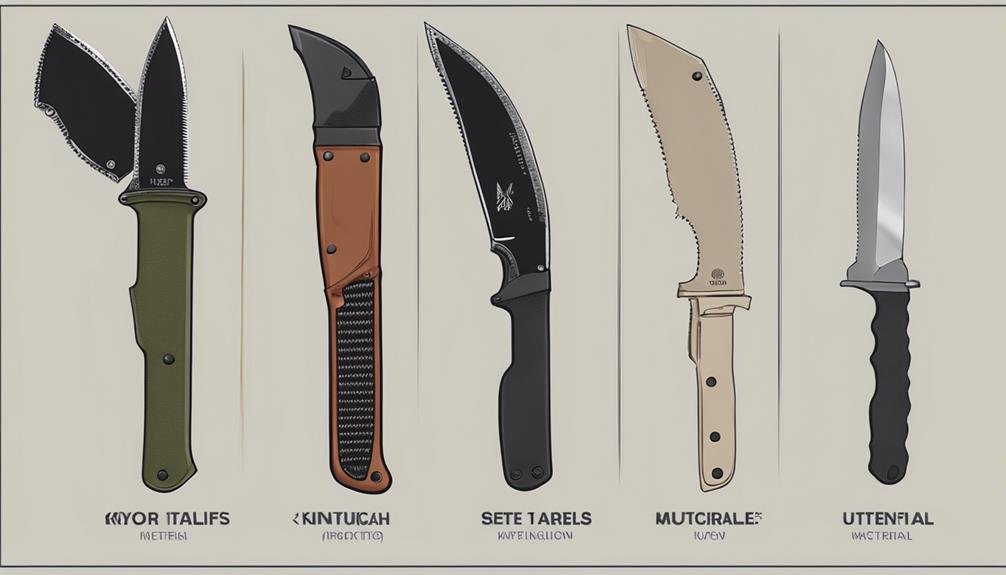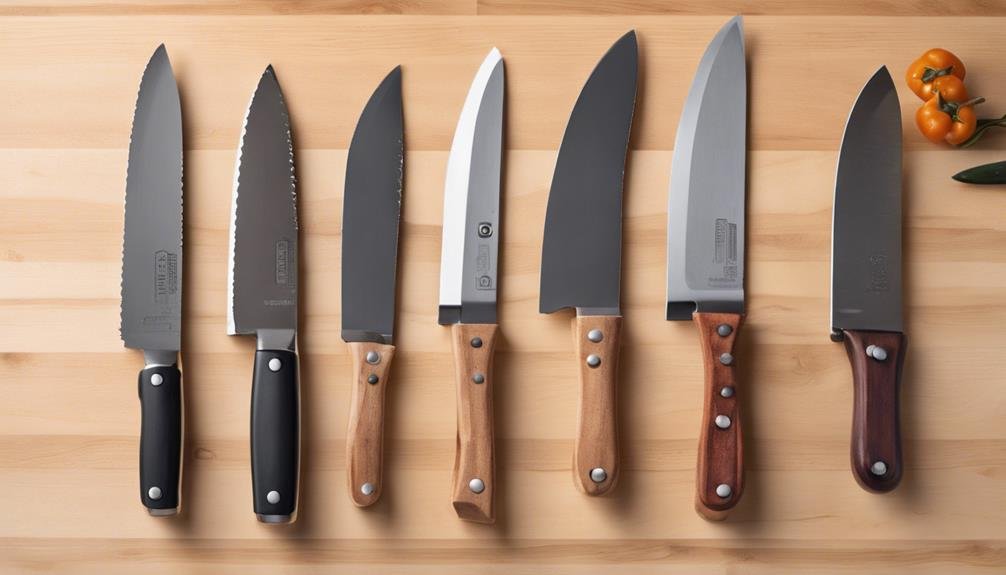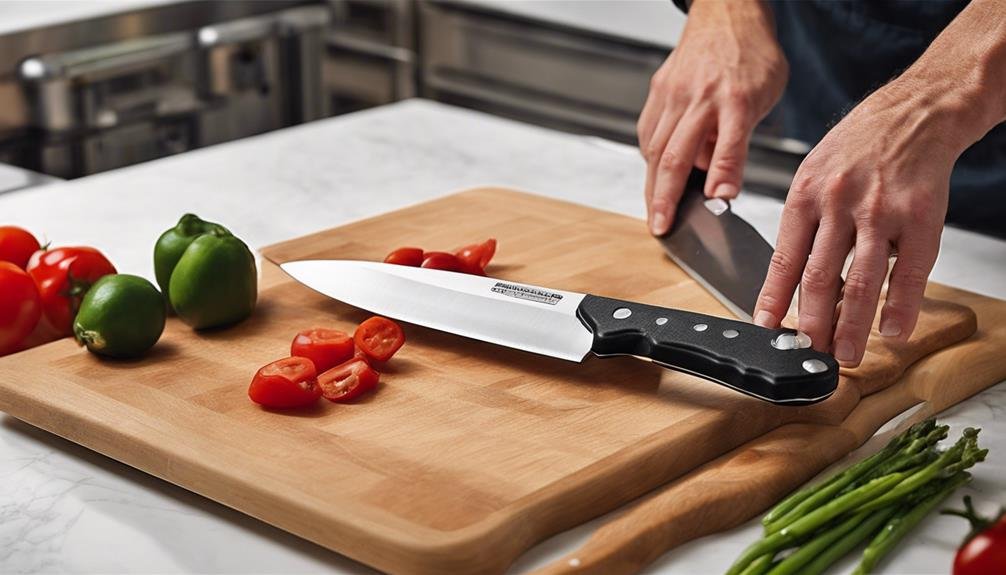The significance of selecting a secure knife attachment cannot be overstated. Ensuring your knife is firmly and safely attached can significantly impact your daily tasks. A secure attachment provides convenience and is essential in maintaining safety standards. Imagine knowing that your knife is always where it should be, ready for use at a moment’s notice. But why stop there? The benefits extend beyond just convenience and safety.
Key Takeaways
- Prevents loss and ensures tools are always accessible.
- Offers peace of mind and boosts confidence in handling tools.
- Enhances efficiency and overall safety in knife usage.
- Balances security with accessibility for a better user experience.
- Protects knives from damage and ensures long-lasting performance.
Benefits of Secure Knife Attachments
When considering knife attachments, the benefits of a secure connection can’t be emphasized enough. Opting for a secure attachment is vital in preventing loss and ensuring your tools are always within reach. Whether engaged in outdoor activities or demanding tasks, a reliable knife attachment offers peace of mind by keeping your knife securely in place.
This secure connection enhances efficiency and boosts your confidence in handling tools effectively.
Importance of Sheath Types
For ideal protection and longevity of your knives, understanding the importance of different sheath types is essential in selecting the right one for your needs. Sheath types like leather, Kydex, and polymer each offer unique benefits in terms of durability and protection for your knives. To make an informed decision, consider the characteristics of each sheath type:
| Sheath Type | Characteristics |
|---|---|
| Leather | Traditional, aesthetic appeal; degrades with water/heat exposure |
| Kydex | Modern, durable, moisture-resistant; ideal for transport |
| Polymer | Stylish, durable, excellent protection for storage/transportation |
Choosing the appropriate sheath type is vital for safeguarding your knives. Leather sheaths provide a classic look but may require more maintenance, while Kydex and polymer sheaths offer modern solutions with enhanced durability and protection. Selecting the right sheath type ensures your knives are well-preserved and ready for any task.
Factors for Knife Attachment Security

Understanding the material and tension of your knife attachment, design considerations, and attachment options is essential to ensuring maximum knife security.
The attachment’s material plays a significant role in terms of security. Opting for materials like stainless steel can enhance the attachment’s overall strength and durability, bolstering its security level.
Additionally, paying attention to the tension in the attachment is important, as it directly impacts how securely the knife is held in place.
Design considerations shouldn’t be overlooked either, as a well-thought-out design enhances aesthetics and contributes to the attachment’s overall security.
Furthermore, exploring various attachment options, such as tip-up or tip-down, can offer different levels of security and accessibility for your knife.
Balancing security with accessibility is key in selecting a knife attachment that meets your needs while prioritizing the safety of your blade.
Secure Knife Attachment Considerations
When choosing a secure knife attachment, focus on safety features that prevent accidental drops.
Consider the durability of materials like stainless steel or titanium for long-lasting security.
Opt for a design that balances aesthetics and functionality to guarantee a smooth carrying experience.
Attachment Safety Features
To guarantee the safety and security of your knife attachment, look for features that prevent accidental drops or loss while providing easy access during use. When considering attachment safety features, opt for mechanisms that offer a secure fit for your knife while allowing for quick retrieval when needed. Features like locking mechanisms, adjustable retention settings, and quick-release options can enhance the overall usability of your attachment. These safety measures reduce the risk of mishandling or dropping your knife and help maintain the blade’s sharpness and integrity. By prioritizing attachment safety features that promote easy access and secure attachment, you can ensure a safer and more efficient knife-handling experience.
| Locking Mechanisms | Adjustable Retention Settings | Quick-Release Options |
|---|---|---|
| Ensures secure fit | Allows customization | Enables quick access |
| Prevents accidental drops | Enhances retention | Facilitates swift retrieval |
| Increases safety | Improves usability | Promotes efficiency |
Attachment Material Durability
For peak durability in your secure knife attachment, prioritize selecting a material that balances strength and weight effectively.
Stainless steel is a common choice. It is known for its durability and corrosion resistance, ensuring longevity and reliability for your attachment.
Titanium is a lightweight yet robust option, perfect for minimizing weight without compromising strength when inserting the knife.
Carbon fiber provides an exceptional strength-to-weight ratio, making it a favored material among knife enthusiasts.
Aluminum balances durability and weight, offering a reliable choice for various environments where your attachment securely fits your knife.
Consider copper for its antimicrobial properties, inhibiting bacterial growth while providing a unique and durable attachment solution.
Evaluating Knife Sheath Material

Evaluating the material of a knife sheath is vital for guaranteeing long-term protection and functionality for your blade. When considering durability, leather sheaths offer a classic look but can degrade when exposed to water or heat. In contrast, Kydex sheaths are modern, durable, and moisture-resistant, maintaining their shape to protect your knife effectively. Polymer sheaths, on the other hand, combine style with durability, making them ideal for safeguarding knives during transport or storage.
Each material has benefits; leather sheaths provide a snug fit but require more maintenance than Kydex or polymer options. Choosing a sheath material that protects your knife and suits your style preferences is important. By carefully evaluating the characteristics of each material, you can select a sheath that ensures the longevity and functionality of your blade while reflecting your innovative approach to knife care.
Securing the Fishing Knife
Securing your fishing knife effectively is crucial for guaranteeing safety and convenience during your outdoor activities. When securing the knife blade, opting for a quick and easy attachment method is vital. A reliable attachment ensures that the knife is readily accessible, especially when quick action is necessary.
Choosing a dependable attachment for your fishing knife reduces the risk of accidental injuries and prevents the tool from getting lost or misplaced in challenging outdoor environments. Properly securing the fishing knife with a high-quality attachment enhances safety measures and promotes efficient and safe handling of the tool, ultimately improving your overall fishing experience.
Whether you prefer a clip-on sheath or a belt loop attachment, the key is to select an option that securely holds the knife in place while allowing for easy access when the knife is needed.
Attachment Options for Safety

When considering attachment options for safety, it’s important to focus on the following:
- Blade lock mechanisms
- Material durability factors
- Proper installation instructions
These aspects ensure your knife stays securely attached to your gear or clothing.
Blade Lock Mechanisms
Selecting the appropriate blade lock mechanism is essential for optimum safety and practicality in knife handling. Different blade lock mechanisms offer varying levels of security and ease of use. Here is a comparison table to help you understand the options better:
| Blade Lock Mechanism | Description | Advantages |
|---|---|---|
| Liner Lock | Uses a side spring bar for one-handed operation | Reliable lockup, easy to use |
| Frame Lock | Utilizes the frame of the knife for strength | Known for strength and reliability |
| Lockback | Features a locking bar that secures the blade | Secure lockup, easy to engage |
| Compression Lock | Uses a small piece of metal to lock the blade | Strong lockup prevents accidental closure |
| Axis Lock | Utilizes a small spring-loaded bar for locking | Ambidextrous, smooth operation |
Understanding these blade lock mechanisms will help you choose the right one for safe and efficient knife handling.
Material Durability Factors
Selecting a durable material is crucial to guarantee the safety and longevity of your pocket knife attachment. When considering material durability factors for your attachment options, stainless steel, titanium, and carbon fiber are top choices.
Stainless steel attachments provide excellent corrosion resistance and strength, making them ideal for everyday carry use. Titanium attachments offer a winning combination of lightweight durability and wear resistance, perfect for rugged conditions. For those seeking a balance of strength and lightness, carbon fiber attachments are the way to go, enhancing the overall durability of your knife carry system.
Choosing a highly durable material ensures the security of your attachment and prevents accidental loss or damage, providing you with peace of mind during daily use.
Installation Instructions
Are you seeking to guarantee the safety and security of your knife attachment through proper installation techniques? When it comes to ensuring the reliability of your attachment, following the correct installation instructions is paramount. Here are some key points to keep in mind:
- Choose the Right Attachment Option: Select between screws, rivets, or clips based on the level of security you require.
- Follow Manufacturer Guidelines: Adhering to the installation instructions provided by the manufacturer is essential for safety and functionality.
- Prevent Accidental Drops: Properly attached knives minimize the risk of accidental drops during daily use.
- Enhance Safety and Performance: Understanding the specific attachment requirements of your knife model will improve both safety and performance.
Selecting a Knife Sheath

When selecting a knife sheath, prioritize a snug fit to safeguard your knife and effectively maintain its sharpness. A properly fitting sheath prevents the blade from shifting, reducing wear and tear while ensuring safety during storage and transportation.
Consider materials like leather, Kydex, and polymer, each offering different levels of durability and protection for your knife. Features such as belt attachments and handle compartments enhance functionality and convenience, allowing for easy access when needed.
Regular inspection, cleaning, and maintenance are essential to maintaining the sheath’s effectiveness and longevity. Choose a sheath that securely fits your knife and suits your lifestyle and usage requirements.
Ensuring Knife Safety
For a reliable and safe knife handling experience, prioritizing a secure attachment is crucial to preventing accidents and maintaining your tool’s condition. When it comes to knife safety, guaranteeing a secure attachment offers several essential benefits:
- Prevents Accidental Drops: A secure attachment ensures the knife is safely and securely held, reducing the risk of accidental drops or loss.
- Enhances Accessibility: It helps prevent injuries by keeping the knife readily accessible when needed, without fumbling or searching for it.
- Minimizes Damage: A secure attachment minimizes damage to the knife blade or handles during transportation or use.
- Boosts Confidence: It enhances user confidence and efficiency in handling the knife, especially in urgent or critical situations.
Sheath Attachment Guide

Mastering the sheath attachment guide is essential for safety and convenience, guaranteeing a secure and reliable knife-carrying experience. Proper sheath attachment ensures secure carrying and prevents accidental cuts or injuries.
When selecting the right attachment style, such as belt loops or clips, you enhance accessibility and convenience, enabling easy access to your knife whenever needed. A snug fit within the sheath prevents knife damage and reflects your style preferences.
Components like handle compartments provide secure storage options and easy-carrying solutions, adding to the sheath’s overall functionality. Regularly inspecting, cleaning, and maintaining sheath attachments are crucial to ensure top-notch performance and durability.
How Does a Gut Hook Attachment Contribute to Knife Security?
A gut hook attachment contributes to knife security by providing a safe and effective way to field dress game. The gut hook’s importance lies in its ability to reduce the risk of accidents while processing meat, ensuring a clean and precise cut without damaging internal organs.
Conclusion
To wrap up, selecting a secure knife attachment ensures safety, efficiency, and peace of mind when handling your tools. As the saying goes, ‘better safe than sorry,’ investing in a reliable attachment can make all the difference in preventing accidents and maximizing productivity.
By carefully considering the factors for security, evaluating sheath materials, and selecting the right attachment option, you can confidently handle your knife with ease and confidence. Choose wisely for a seamless and safe experience.
FAQs
Why Is It Important to Select the Right Type of Knife for the Job?
When you select the right type of knife for the job, you improve your cutting precision and efficiency. Proper grip and cutting techniques are enhanced when you match the knife to the task.
This guarantees smoother cuts, reduces effort, and minimizes the risk of accidents. Specialized knives excel in specific functions, allowing you to work with more control and achieve better results.
Choose wisely to optimize your performance in the kitchen or any cutting task.
Why Are Knife Holders Important?
Proper knife storage in holders is essential for safety precautions and efficient organization. They keep your knives easily accessible, reducing the risk of accidental cuts.
Additionally, knife holders protect blades from damage and environmental factors, extending their lifespan. Choosing the right holder, whether a block, rack, bag, or roll, guarantees convenience and safety in home and professional kitchens.
Selecting a suitable knife holder is vital for maintaining kitchen efficiency and safety.
What Are Factors to Consider When Choosing a Knife?
When choosing a knife, consider weight balance like a tightrope walker. Look for a blade material that suits your needs. Stainless steel offers durability, while carbon steel provides excellent sharpness.
Make sure the knife feels comfortable in your hand and has a handle that offers a secure grip. Check the blade length, edge type, and overall design for functionality.
Prioritize a knife that meets your specific needs and preferences for a versatile tool.
Why Is It Important to Know How You Correctly Hold a Knife?
Knowing how to hold a knife correctly is essential for your safety and efficiency in the kitchen. Proper grip reduces the risk of accidents and enhances your control and precision when cutting.
Mastering the correct technique minimizes fatigue and allows for better blade manipulation. Understanding the importance of a secure knife grip can greatly improve your safety and cutting skills.

